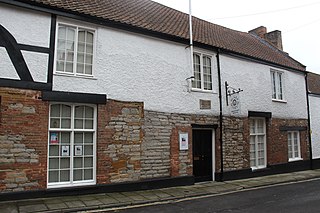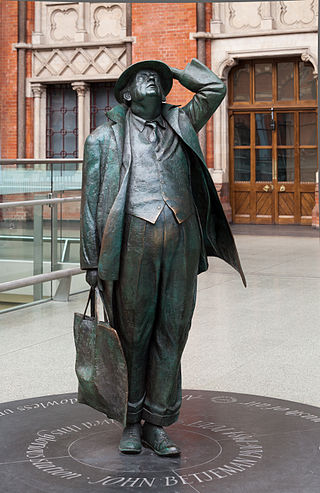
Bridgwater is a historic market town and civil parish in Somerset, England. The town had a population of 41,276 at the 2021 Census. Bridgwater is at the edge of the Somerset Levels, in level and well-wooded country. The town lies along both sides of the River Parrett; it has been a major inland port and trading centre since the industrial revolution. Most of its industrial bases still stand today. Its larger neighbour, Taunton, is linked to Bridgwater via a canal, the M5 motorway and the GWR railway line.

Robert Blake was an English naval officer who served as the Lord Warden of the Cinque Ports from 1656 to 1657. Blake is recognized as the chief founder of England's naval supremacy, a dominance subsequently inherited by the British Royal Navy well into the early 20th century. Despite this, due to deliberate attempts to expunge the Parliamentarians from historical records following the Stuart Restoration, Blake's achievements tend to remain unrecognized. Blake's successes have been considered to have "never been excelled, not even by Nelson" according to one biographer.

The Tower Hill Memorial is a pair of Commonwealth War Graves Commission memorials in Trinity Square Gardens, on Tower Hill in London, England. The memorials, one for the First World War and one for the Second, commemorate civilian, merchant seafarers and fishermen who were killed as a result of enemy action and have no known grave. The first, the Mercantile Marine War Memorial, was designed by Sir Edwin Lutyens and unveiled in 1928; the second, the Merchant Seamen's Memorial, was designed by Sir Edward Maufe and unveiled in 1955. A third memorial, commemorating merchant seamen who were killed in the 1982 Falklands War, was added to the site in 2005.

The Anglo-Spanish War was a conflict between the English Protectorate under Oliver Cromwell, and Spain, between 1654 and 1660. It was caused by commercial rivalry. Each side attacked the other's commercial and colonial interests in various ways such as privateering and naval expeditions. In 1655, an English amphibious expedition invaded Spanish territory in the Caribbean. In 1657, England formed an alliance with France, merging the Anglo–Spanish war with the larger Franco-Spanish War resulting in major land actions that took place in the Spanish Netherlands.

Frederick William Pomeroy was a prolific British sculptor of architectural and monumental works. He became a leading sculptor in the New Sculpture movement, a group distinguished by a stylistic turn towards naturalism and for their works of architectural sculpture. Pomeroy had several significant public works in London and elsewhere in the United Kingdom, notably in Belfast. His work in London includes the figure of Lady Justice (1905–1906) on the dome of the Old Bailey.
Events from the year 1657 in England.

The Blake Museum is in Bridgwater, Somerset, England at what is believed to be the birthplace of Robert Blake, General at Sea (1598–1657). Since April 2009 it has been run by Bridgwater Town Council with help from the Friends of Blake Museum. It has been an Accredited Museum since 2006. It is next door to the Bridgwater Town Mill, and there are plans to develop this as an extension of the museum.

Robert Blake School, formerly Robert Blake Science College, is a mixed secondary school in Bridgwater, Somerset, England.

The Corn Exchange is a commercial building in Cornhill, Bridgwater, Somerset, England. The structure, which is now used as a shopping arcade, is a Grade I listed building.

Admiral David G. Farragut is a statue in Washington, D.C., honoring David Farragut, a career military officer who served as the first admiral in the United States Navy. The monument is sited in the center of Farragut Square, a city square in downtown Washington, D.C. The statue was sculpted by female artist Vinnie Ream, whose best-known works include a statue of Abraham Lincoln and several statues in the National Statuary Hall Collection. The monument was dedicated in 1881 in an extravagant ceremony attended by President James A. Garfield, members of his cabinet, and thousands of spectators. It was the first monument erected in Washington, D.C., in honor of a naval war hero.

Martin Jennings, FRBS is a British sculptor who works in the figurative tradition, in bronze and stone. His statue of John Betjeman at St Pancras railway station was unveiled in 2007 and the statue of Philip Larkin at Hull Paragon Interchange station was presented in 2010. His statue of Mary Seacole (2016), one of his largest works, stands in the grounds of St Thomas' Hospital in central London, looking over the Thames towards the Houses of Parliament.

The Old Steine Gardens in Brighton, Brighton and Hove, East Sussex, England, adjacent to the Old Steine thoroughfare, are the site of several monuments of national historic significance.

The Statue of Queen Victoria stands in front of Chester Crown Court in the forecourt of Chester Castle, Chester, Cheshire, England. It was unveiled in 1903, the sculptor was Frederick William Pomeroy, and the statue is recorded in the National Heritage List for England as a designated Grade II listed building.

A bronze statue of Henry Havelock by the sculptor William Behnes, stands in Trafalgar Square in London, United Kingdom. It occupies one of the four plinths in Trafalgar Square, the one to the southeast of Nelson's Column.

The Portsmouth Naval Memorial, sometimes known as Southsea Naval Memorial, is a war memorial in Portsmouth, Hampshire, England, on Southsea Common beside Clarence Esplanade, between Clarence Pier and Southsea Castle. The memorial commemorates approximately 25,000 British and Commonwealth sailors who were lost in the World Wars, around 10,000 sailors in the First World War, and 15,000 in the Second World War. The memorial features a central obelisk, with names of the dead on bronze plaques arranged around the memorial according to the year of death.

The Equestrian statue of Ferdinand Foch stands in Lower Grosvenor Gardens, London. The sculptor was Georges Malissard and the statue is a replica of another raised in Cassel, France. Foch, appointed Supreme Commander of the Allied Forces on the Western Front in the Spring of 1918, was widely seen as the architect of Germany's ultimate defeat and surrender in November 1918. Among many other honours, he was made an honorary Field marshal in the British Army, the only French military commander to receive such a distinction. Following Foch's death in March 1929, a campaign was launched to erect a statue in London in his memory. The Foch Memorial Committee chose Malissard as the sculptor, who produced a replica of his 1928 statue of Foch at Cassel. The statue was unveiled by the Prince of Wales on 5 June 1930. Designated a Grade II listed structure in 1958, the statue's status was raised to Grade II* in 2016.

Twickenham War Memorial, in Radnor Gardens, Twickenham, London, commemorates the men of the district of Twickenham who died in the First World War. After 1945, the memorial was updated to recognise casualties from the Second World War. The memorial was commissioned by Twickenham Urban District Council in 1921. It was designed by the sculptor Mortimer Brown, and is Brown's only significant public work. The memorial is unusual for its representation of a jubilant soldier returning home. It became a Grade II* listed structure in 2017.

Scott Sutherland was a Scottish sculptor, best known for the Commando Memorial in Spean Bridge. He was Head of Sculpture at Duncan of Jordanstone College of Art
The Bank of England War Memorial, in the internal Garden Court at the headquarters of the Bank of England in the City of London, commemorates the bank's staff who were killed while serving in the First World War and Second World War. It includes a bronze sculpture by Richard Reginald Goulden portraying Saint Christopher carrying the Christ Child. It became a Grade II listed building in 2017. The surrounding buildings of the bank are separately listed at Grade I.


















